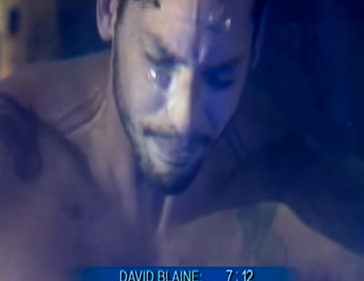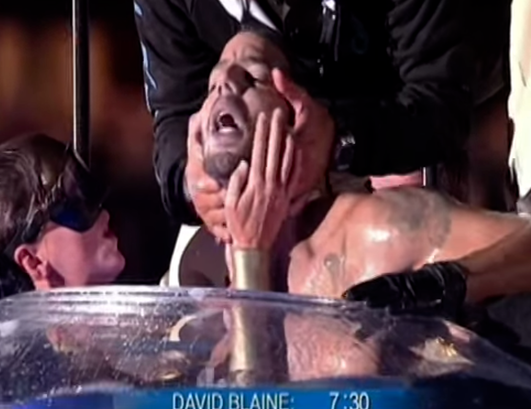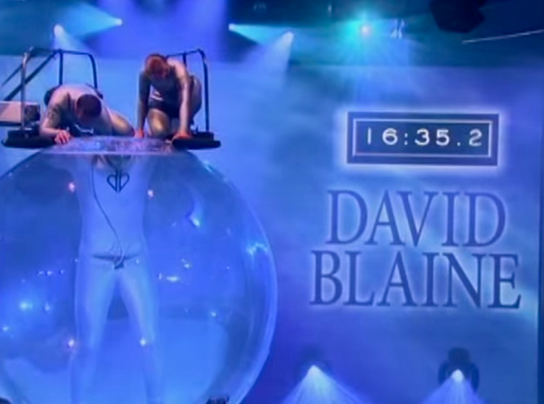"It's practice, it's training, and experimenting while pushing through the pain to be the best that I can be. That's what magic is to me." ~ David Blaine
- Buried alive in NYC for 7 days in a coffin with nothing but water. (This fun underground experiment piqued Blaine's interest in the practice of extreme aestheticism.)
- Froze himself in a block of ice for 3 days. (A freezing feat much more difficult than he originally expected.)
- Balanced himself on top of a 100-foot pillar for 36 hours. (The Brooklyn magician claims he hallucinated so hard he felt as if the buildings were transforming into big animal heads.)
- Lived in a small glass box suspended over London for 44 days with nothing but water. (Blaine claims this was the most beautiful experience of his life.)
In the TED Talk, Blaine recalled an incredible article he came across describing an 11 year-old boy falling into a frozen river and being rescued after spending 45 minutes under water. Although the boy's body temperature was 77 degrees, the doctors were not able to find any sign of brain damage. How was this phenomenon biologically possible? There were no illusions or tricks involved in this underwater spectacle, only the will of the boy to survive in a freezing, airless underwater world for almost an hour. "As a magician I think everything is possible, and I think if something is done by one person it can be done by others." Deeply convinced by this belief, Blaine became interested in replicating a similar biological feat. He submerged himself in ice water thinking the cold water might assist him in holding his breath for an extremely long period of time, but the ice water was obviously so cold he could barely stay underwater for a minute.
The Brooklyn native continued his breath-holding research by looking into the world of pearl divers. These peculiar human dolphins are able to dive to the bottom of the sea and hunt for pearls for four minutes at a time equipped with nothing but one gulp of air. It was in the midst of researching pearl divers that Blaine discovered the parallel world of free diving. In the TEDMED Talk Blaine pointed out that, "it was the most amazing thing I've ever discovered, pretty much."
Free diving is a complicated sport divided into many different types of competition. However, it can be simplified into two major categories: depth records and static apnea. Depth records involve divers attempting to dive down as deep as they can, whether they are using weights, no weights, or machine assistance. The current no limit world record is held by the Austrian free diver, Herbert Nitsch at an incomprehensible 831 feet! At the opposite end of free diving competition exists the practice of static apnea, which is the motionless ability to hold your breath for as long as you possibly can—this is what David Blaine began to involve himself in.
There are a few key skills a static apnea practitioner should have developed and refined. For example, the competitor should never move at all because each bodily movement depletes the competitor's ever-so-valuable molecule of oxygen and in turn increases the levels of carbon dioxide in the body. Also, the competitor should never let a bubble of air out. Another key skill is learning to decelerate one's heart rate. A slower heart rate plays a huge part in oxygen retention. Blaine accelerated in this department by having a resting heart rate of 38 beats per minute (equal to most olympic athletes) and by learning out-of-body, meditative techniques he was able to slow his heart rate down to a remarkable 12 beats per minute while under water. Another critical technique is learning the art of "purging." Purging is of utmost importance. It is similar to the psychedelic-inducing practice of Stan Grof's Holotropic Breathing, in that it involves hyperventilation in order to "purge" or rid the body of all signs of carbon dioxide trapped in the practitioner's body. Lastly, one must attempt to relax through all the pain accompanying the art of no breathing. Static apnea surely teaches you to exceed your own delusional limits.
In the months leading up to his attempt at breaking the world record, Blaine synthesized his own static apnea practice by sleeping in a hypoxic (high-altitude) tent and adhering to a morning breath-holding ritual for months at a time. He would begin his morning by holding his breath for 5.5 minutes and "purging" for 1 minute immediately after that; then he would hold his breath for another 5.5 minutes, and "purge" for 1 minute after that. He repeated this routine for a total of 52 minutes every morning, and in that 52 minute span he was only breathing (hyperventilating) for 8 minutes in total. Another one of his unique methods of practice involved holding his breath under extreme duress. Some of these extreme environments involved keeping a breathless calm in cold water and shark tanks. Keep in mind that a slow heart rate is an incredibly important attribute to have in the free diving world.
"As a magician I think everything is possible, and I think if something is done by one person it can be done by others."






 RSS Feed
RSS Feed
